Mastering Wok Techniques: From Basic Stir-Frying to Advanced Multi-Method Cooking
Mastering Wok Techniques: From Basic Stir-Frying to Advanced Multi-Method Cooking
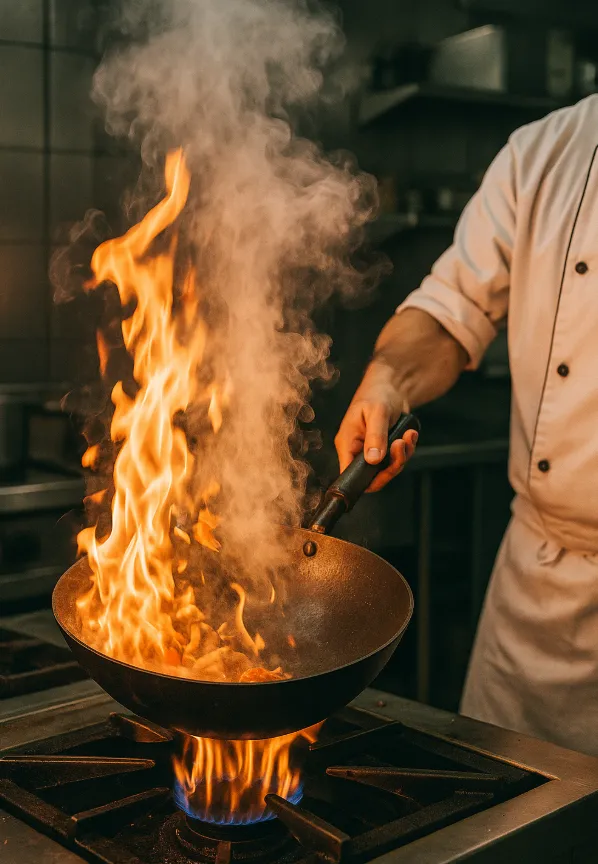 High-heat stir-frying technique showing the dynamic motion and intense heat of proper wok cooking
High-heat stir-frying technique showing the dynamic motion and intense heat of proper wok cooking
The true value of a wok in a home kitchen is revealed not just by its ability to create a superior stir-fry, but by its capacity to effectively replace several other specialized pans. This versatility makes it a space- and cost-efficient "power tool" for the discerning cook. Mastering a few fundamental principles and techniques unlocks this vast potential, transforming your cooking from ordinary to extraordinary.
Technique Truth: A wok is only as good as the cook who wields it. Even the finest carbon steel wok will produce mediocre results without proper technique, while a skilled cook can achieve remarkable results with basic equipment.
These modern techniques preserve ancient wok cooking principles developed over millennia, while adapting them for contemporary kitchens and ingredients.
The Foundation: Mise en Place and Preparation
The French Secret in Chinese Cooking
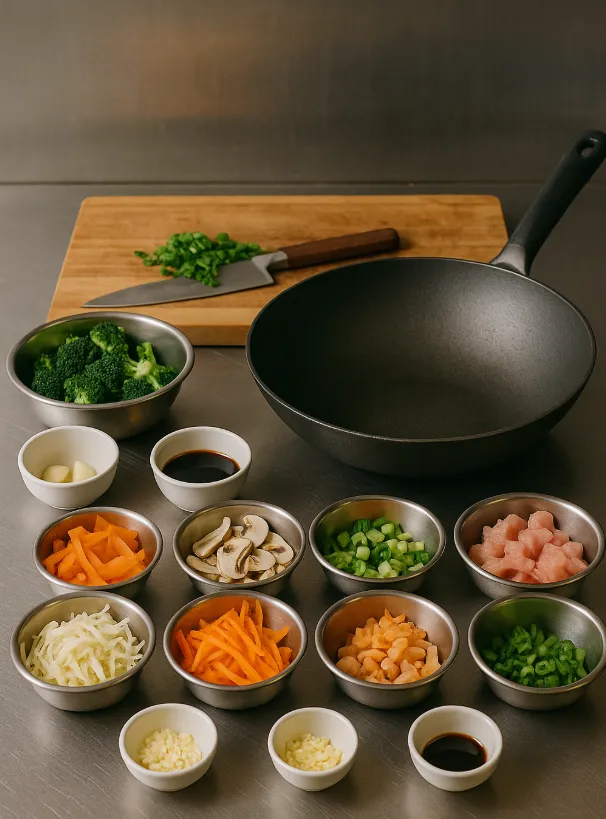 Ingredients organized and prepped for efficient wok cooking workflow
Ingredients organized and prepped for efficient wok cooking workflow
Wok cooking is defined by its speed. A stir-fry can be completed in minutes, leaving no time to chop vegetables or measure sauces mid-process. Therefore, the French concept of mise en place—having all ingredients prepped, measured, and arranged within arm's reach before cooking begins—is not just a suggestion, it is a strict requirement.
Timing Reality: Professional wok cooking happens in 30-90 seconds per dish. There's literally no time to prep ingredients once cooking begins. Preparation is everything.
Achieving these lightning-fast results requires proper kitchen setup and heat management that can maintain consistent high temperatures throughout the cooking process.
Essential Mise en Place for Wok Cooking:
- Proteins: Cut into uniform, bite-sized pieces
- Aromatics: Garlic minced, ginger julienned, scallions sliced
- Vegetables: Cut to appropriate sizes, harder vegetables smaller
- Sauces: Pre-mixed in small bowls or ramekins
- Oils: Measured and ready in easy-pour containers
- Garnishes: Chopped herbs, sesame seeds, etc., ready for finishing
Ingredient Preparation Philosophy
Size Consistency: All ingredients should be cut to similar sizes to ensure even cooking. This is particularly crucial for vegetables that will cook together.
Surface Area Maximization: Thin slices and small pieces cook faster and more evenly, essential for the rapid-fire nature of wok cooking.
Strategic Grouping: Organize ingredients by cooking time and method—aromatics together, proteins by type, vegetables by density.
Professional Tip: Restaurant kitchens prep ingredients hours ahead and store them in refrigerated containers. Home cooks can adopt this practice for efficient weeknight cooking.
The "Hot Wok, Cold Oil" Secret
Equally critical is the technique known as "hot wok, cold oil," or longyau in professional Chinese kitchens. This fundamental principle separates amateur from professional results and requires the right wok choice to execute properly.
The Science Behind the Technique
The Process:
- Heat the empty wok over high heat until it is ripping hot and just beginning to emit wisps of smoke
- Add your cooking oil, swirl it to coat the surface
- Immediately add your first ingredients
Physics Explanation: Heating the metal causes its microscopic pores to expand. When cooler oil is added, it creates a temporary vapor barrier that prevents food from sticking. This is the foundation of non-stick cooking in an unseasoned or lightly seasoned wok.
Advanced techniques showcase why carbon steel outperforms other materials in achieving this critical temperature control and responsiveness.
Why This Works:
- Prevents sticking: The vapor barrier eliminates the need for excessive oil
- Prevents oil breakdown: Adding oil to a hot pan prevents it from slowly heating and developing bitter, burnt flavors
- Creates proper searing: The immediate high heat creates the Maillard reaction essential for flavor
- Establishes control: You start cooking at maximum heat and can adjust down as needed
Temperature Indicators
Visual Cues for Proper Heat:
- Wisps of smoke: The wok is ready when you see light smoke rising
- Water test: A drop of water should sizzle and evaporate within 1-2 seconds
- Oil behavior: Oil should shimmer and move freely when swirled
- Sound test: A piece of garlic should sizzle aggressively when added
Safety Note: Always have your ingredients ready before heating the wok. A properly heated wok waits for no one and can go from perfect to overheated quickly.
The Signature Move: Stir-Frying (Chao)
Stir-frying is a dynamic process of constant motion. It is not simply stirring food in a hot pan—it's a carefully orchestrated dance of ingredients, heat, and timing.
The Classical Sequence
Stage 1: Aromatics (5-10 seconds) Start with garlic, ginger, and other aromatics. These release their essential oils quickly and create the flavor foundation.
Stage 2: Proteins (30-60 seconds) Add proteins next, allowing them to sear and develop color before pushing them up the sides of the wok.
Stage 3: Vegetables (30-90 seconds) Add vegetables in order of cooking time—harder vegetables first, softer ones last.
Stage 4: Sauce and Finishing (10-30 seconds) Add pre-mixed sauces and any final seasonings, tossing to coat everything evenly.
Timing Mastery: Professional chefs often cook multiple woks simultaneously because each stage is precisely timed. Developing this internal clock is key to wok mastery.
Heat Zone Management
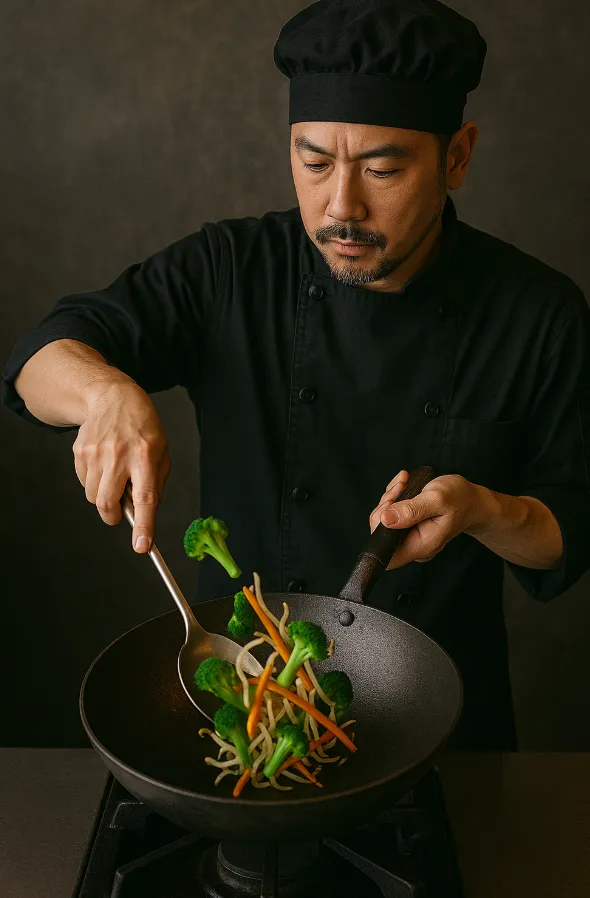 Professional chef demonstrating proper wok tossing and ingredient manipulation
Professional chef demonstrating proper wok tossing and ingredient manipulation
The wok's unique shape creates distinct temperature zones that skilled cooks exploit:
The Well (Bottom Center): Hottest zone for searing and initial cooking The Slopes (Sides): Cooler zones for holding cooked ingredients The Rim (Top Edge): Coolest zone for keeping ingredients warm
Strategic Movement: Ingredients are typically seared in the well at the bottom, then pushed up the sloping sides to continue cooking more gently while the hot zone is cleared for the next ingredient. This allows multiple components to cook simultaneously at different intensities within the same pan.
The Art of Tossing
Proper Wok Tossing Technique:
- Grip: Hold the handle firmly with your dominant hand
- Motion: Quick, confident flick of the wrist upward and forward
- Timing: Toss when ingredients need to be redistributed or mixed
- Rhythm: Develop a consistent rhythm for even cooking
Learning Curve: Tossing takes practice. Start with small amounts of lightweight ingredients like bean sprouts before attempting heavier items like chunks of meat.
Beyond the Stir-Fry: The Wok's True Versatility
While synonymous with stir-frying, the wok is a genuine multi-purpose vessel capable of a wide range of cooking methods, making it one of the most versatile tools in any kitchen.
Deep-Frying: Efficiency and Safety
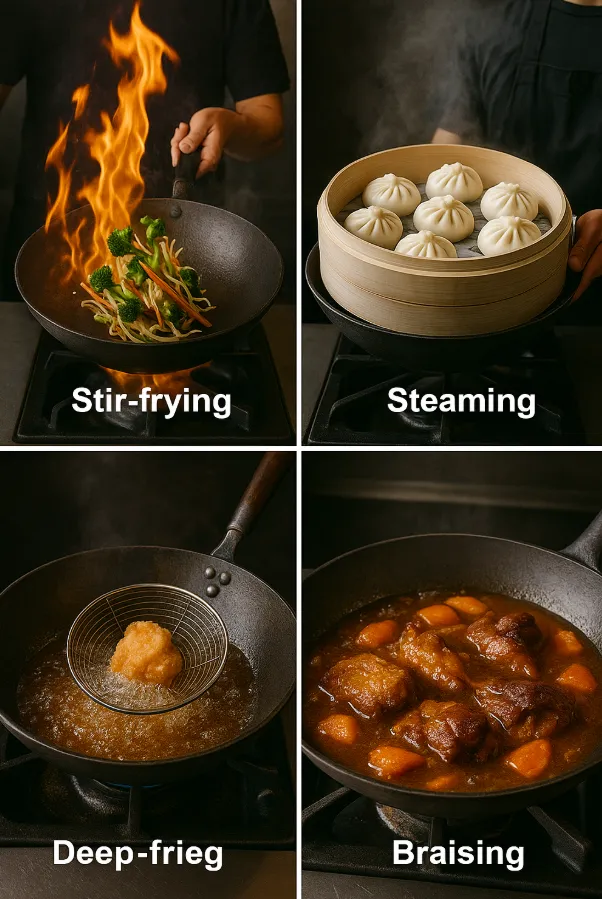 Collage showing multiple wok cooking methods beyond stir-frying
Collage showing multiple wok cooking methods beyond stir-frying
The wok's conical shape is exceptionally well-suited for deep-frying. It requires significantly less oil to achieve the necessary depth compared to a straight-sided pot or Dutch oven. The wide, flared sides also act as a natural splatter guard, making the process safer and cleaner.
Deep-Frying Advantages:
- Oil efficiency: Uses 30-40% less oil than traditional pots
- Temperature control: Wide surface area allows for better heat distribution
- Splatter protection: Sloped sides contain oil splatter naturally
- Easy retrieval: Wide opening makes removing food easier
Essential Deep-Frying Technique:
- Oil temperature: Maintain 350-375°F (175-190°C) for most applications
- Oil level: Fill wok 1/3 to 1/2 full maximum
- Batch size: Don't overcrowd to maintain temperature
- Retrieval tool: Use a long-handled spider strainer for safety
Safety Priority: Always use a thermometer for oil temperature. Overheated oil can ignite, while underheated oil results in greasy, soggy food.
Steaming: Gentle and Healthy
With the addition of a simple steaming rack and a lid, a wok transforms into a highly effective steamer. It is ideal for cooking delicate items like fish, vegetables, or dim sum such as dumplings and buns.
Steaming Setup:
- Rack placement: Position steaming rack 2-3 inches above water level
- Water management: Maintain consistent steam without boiling dry
- Lid selection: Dome-shaped lid prevents condensation dripping
- Bamboo steamers: Traditional bamboo steamer baskets fit perfectly
Steaming Benefits:
- Nutrient retention: Gentle cooking preserves vitamins and minerals
- Texture preservation: Maintains natural textures and colors
- Flavor purity: No added fats, pure ingredient flavors
- Versatility: From vegetables to fish to dumplings
Braising and Stewing: Slow and Flavorful
The wok's shape is excellent for braising. Meats or vegetables can be seared first, after which liquid is added. The narrow base minimizes the chance of scorching, while the wide surface area encourages rapid evaporation and concentration of sauces.
Braising Technique:
- Sear first: Brown proteins in the wok bottom for flavor development
- Add liquids: Wine, stock, or water to create braising medium
- Simmer control: Lower heat to maintain gentle bubbling
- Reduction: Use wide surface area for sauce concentration
Smoking: Indoor Flavor Enhancement
For the more adventurous cook, a wok can be converted into an indoor smoker. By placing wood chips or tea leaves in the bottom, setting a rack above them, and covering with a tight-fitting lid, one can impart smoky flavor to meats, cheeses, or vegetables.
Indoor Smoking Setup:
- Base material: Wood chips, tea leaves, or rice for different flavors
- Rack elevation: Position food above smoking material
- Ventilation: Ensure adequate kitchen ventilation
- Temperature control: Use low heat to create smoke without burning
Ventilation Critical: Indoor smoking requires excellent ventilation. Consider this technique only with powerful range hoods or outdoor setups.
Other Applications
The wok's utility extends even further:
Boiling: Excellent for noodles and pasta with easy retrieval Popping: Makes perfect popcorn with easy tossing Roasting: Great for nuts and spices with constant motion Scrambling: Large surface area perfect for fluffy eggs
Chasing the Dragon's Breath: The Elusive Quest for Wok Hei
For many aspiring home cooks, the pursuit of authentic, restaurant-level results represents the ultimate culinary challenge. In the realm of wok cooking, this ambition is embodied by the quest for wok hei.
Defining the Phenomenon
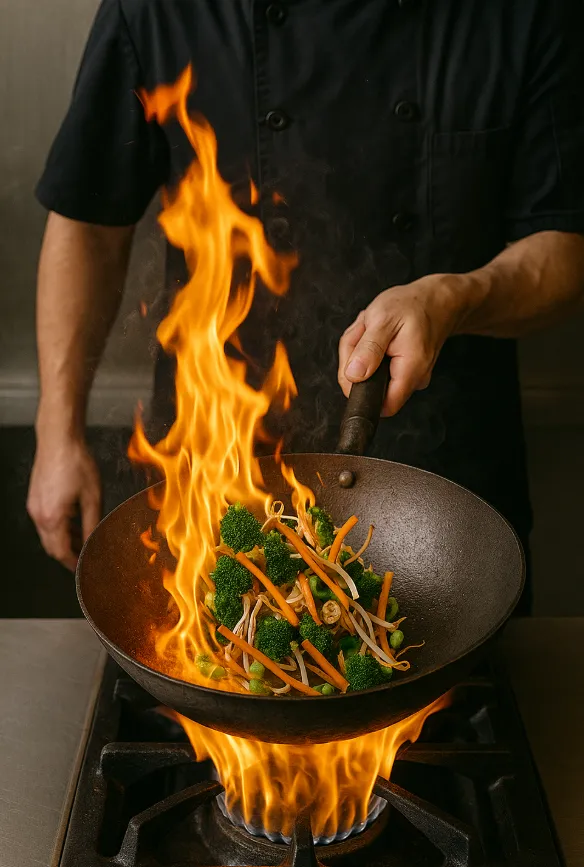 Food being tossed in wok with visible flames creating wok hei
Food being tossed in wok with visible flames creating wok hei
Wok hei, literally "the breath of the wok," is the unique, smoky, and deeply savory flavor that distinguishes a truly great stir-fry. It is often described as elusive and hard to pin down, but its origin lies in a specific set of high-temperature chemical reactions.
Flavor Science: Wok hei is not simply the taste of browned food (Maillard reaction) or caramelization, although those are components. True wok hei involves the controlled combustion of aerosolized fats and food particles.
The Chemistry of Wok Hei: True wok hei is achieved when tiny droplets of oil and microscopic food particles are tossed into the superheated plume of air above the wok. They combust, creating a unique spectrum of flavor compounds that then fall back down and coat the ingredients in the pan. This process requires the simultaneous occurrence of three cooking methods:
- Intense conductive searing from the hot metal
- Steaming from the food's own moisture being released
- Smoky flavor imparted by controlled combustion of aerosolized fats
The Home Kitchen Challenge
Replicating this complex phenomenon at home is notoriously difficult. The primary obstacle is heat. Professional Chinese restaurant kitchens are equipped with dedicated wok ranges that feature monstrous burners, often producing over 100,000 BTU and sounding like a jet engine.
The Heat Differential:
- Professional wok station: 100,000-200,000 BTU
- High-end home gas burner: 15,000-27,000 BTU
- Standard home burner: 7,000-15,000 BTU
Reality Check: Even the most powerful home burners produce 1/10th the heat of professional wok stations. This isn't just about speed—it's about achieving entirely different chemical reactions.
The Temperature Drop Problem: On a standard home stove, the moment a significant amount of cold food is added to the hot wok, the pan's temperature plummets. The intense heat required for searing and combustion is lost, and the food begins to boil and steam in its own juices instead of frying, making wok hei impossible to achieve.
Clever Tricks: Approximating the Effect
For the dedicated home cook unwilling to accept defeat, several methods and "hacks" have been developed to approximate the intense heat needed for wok hei.
Outdoor Burners: The Direct Solution
The most effective and direct solution is to take the cooking outside. High-pressure propane burners, often sold for turkey frying or found at Asian markets, can generate the massive heat output needed to replicate a professional wok station.
Outdoor Burner Benefits:
- Heat output: 50,000-150,000+ BTU capability
- Temperature maintenance: Wok stays hot when food is added
- Ventilation: No indoor smoke concerns
- Authentic experience: Closer to traditional Chinese outdoor cooking
The Grill Method
A very hot charcoal or gas grill can also serve as an excellent heat source for a wok. Placing a carbon steel wok directly on the grates of a grill preheated to its maximum temperature can generate enough heat to get close to the desired effect.
Grill Technique:
- Preheat thoroughly: 15-20 minutes at maximum temperature
- Direct contact: Round-bottom wok sits naturally in grates
- Heat concentration: Charcoal provides intense, focused heat
- Wind management: Shield from wind for consistent heat
Advanced Techniques: The Torch Method
A more recent and audacious technique involves using a handheld kitchen blowtorch (the kind used for crème brûlée) during the stir-frying process.
Torch Technique: The torch is not aimed directly at the food, but rather at the space just above it, igniting the oil vapors and food particles that are tossed into the air. This directly simulates the combustion aspect of wok hei.
Safety Critical: This method requires extreme caution, excellent ventilation, and proper fire safety measures, such as keeping a lid nearby to snuff out any flare-ups. Only attempt with proper training and safety equipment.
Safety Requirements:
- Ventilation: Commercial-grade range hood or outdoor setup
- Fire safety: Fire extinguisher and lid readily available
- Training: Practice torch control before attempting
- Clear workspace: Remove all flammable materials
Technique Over Technology
Even on a standard indoor stove, certain principles can help you get closer to the goal:
Fundamental Principles:
- Well-seasoned wok: Essential for proper heat transfer and non-stick properties
- Maximum preheating: Heat until wisps of smoke appear
- Small batches: Cook 1-2 servings maximum to prevent temperature drop
- High-heat ingredients: Use room temperature ingredients to minimize cooling
- Constant motion: Keep food moving to prevent burning and promote even cooking
Home Optimization Strategies:
- Ingredient temperature: Bring proteins to room temperature before cooking
- Batch cooking: Cook components separately and combine at the end
- Heat recovery: Allow wok to reheat between ingredient additions
- Oil selection: Use high-smoke-point oils that can handle extreme heat
Advanced Wok Techniques
Sequential Cooking Method
Professional Workflow:
- Aromatics first: Garlic, ginger, scallions for 5-10 seconds
- Proteins isolated: Cook and remove to maintain texture
- Vegetables by density: Hard vegetables first, soft ones last
- Recombination: Return proteins and add sauce
- Final toss: Quick mixing and immediate serving
Velveting: The Restaurant Secret
Velveting Technique: A pre-cooking method where proteins are marinated in egg white and cornstarch, then briefly blanched in oil or water before stir-frying.
Benefits:
- Tender texture: Proteins remain incredibly tender
- Moisture retention: Prevents overcooking
- Professional results: Mimics restaurant texture
- Versatility: Works with chicken, beef, pork, and seafood
Sauce Integration Mastery
Professional Sauce Technique:
- Thickening agents: Cornstarch slurry added at the end
- Glossy finish: Quick tossing creates restaurant-style shine
- Temperature control: Add sauce to hot wok for immediate integration
- Coating technique: Continuous motion ensures even distribution
Regional Applications of Advanced Techniques
Japanese Chuka Ryori Applications
Apply these techniques to master Japanese chuka ryori dishes like gyoza and mabo tofu. The precise temperature control and heat zone management are particularly crucial for achieving the delicate balance of flavors in Japanese-style Chinese cuisine.
Korean-Chinese Fusion Mastery
Use wok hei principles for authentic Korean-Chinese flavors in jajangmyeon and jjamppong. The high-heat techniques are essential for the bold, robust flavors that define Korean-Chinese cuisine.
Vietnamese Xào Precision
Adapt these methods for Vietnamese xào techniques and delicate stir-frying. The emphasis on precise timing and temperature control aligns perfectly with Vietnamese cooking philosophy.
The Philosophy of Wok Mastery
Understanding Heat as a Tool
Successful wok cooking requires thinking of heat not as a setting, but as an ingredient. Like salt or acid, heat must be applied at the right time, in the right amount, for the right duration.
Developing Wok Instincts
Professional Development:
- Sound recognition: Learn to identify proper sizzling
- Visual cues: Recognize when ingredients are properly cooked
- Timing internalization: Develop internal clock for each stage
- Recovery techniques: Learn to correct common mistakes
The Continuous Learning Journey
Skill Progression:
- Basic competency: Consistent stir-fries without burning
- Intermediate skills: Multi-component dishes with proper timing
- Advanced techniques: Wok hei approximation and restaurant-quality results
- Mastery: Intuitive cooking with perfect heat control
Mastery Mindset: Even professional wok chefs continue learning and refining their technique throughout their careers. Embrace the journey rather than expecting immediate perfection.
Mastering the wok is ultimately about understanding and respecting the relationship between heat, timing, and technique. Whether you're creating a simple vegetable stir-fry or pursuing the elusive wok hei, the principles remain the same: preparation, heat management, and constant motion. With practice and patience, the wok becomes not just a cooking tool, but an extension of your culinary creativity and skill.
This concludes our comprehensive 8-part series exploring everything you need to know about wok cooking. From ancient history to modern techniques, you now have the knowledge to embark on your own wok cooking journey.
Comments
Post a Comment